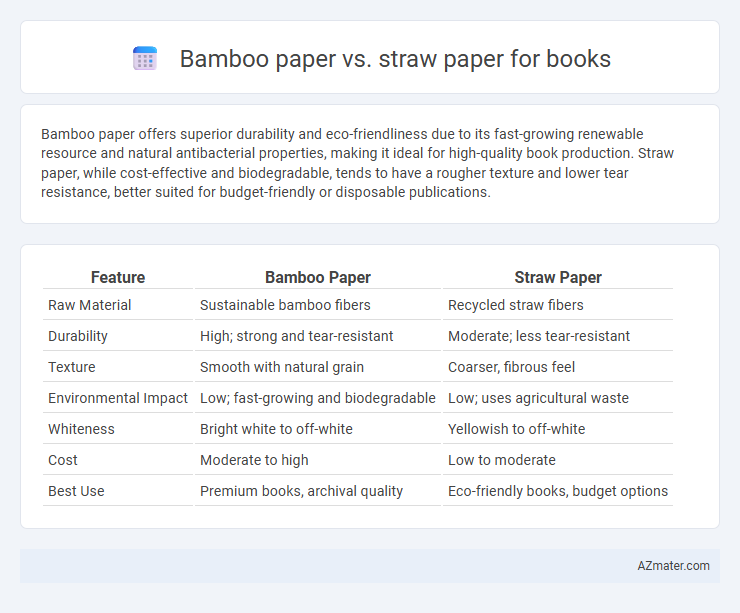Bamboo paper offers superior durability and eco-friendliness due to its fast-growing renewable resource and natural antibacterial properties, making it ideal for high-quality book production. Straw paper, while cost-effective and biodegradable, tends to have a rougher texture and lower tear resistance, better suited for budget-friendly or disposable publications.
Table of Comparison
| Feature | Bamboo Paper | Straw Paper |
|---|---|---|
| Raw Material | Sustainable bamboo fibers | Recycled straw fibers |
| Durability | High; strong and tear-resistant | Moderate; less tear-resistant |
| Texture | Smooth with natural grain | Coarser, fibrous feel |
| Environmental Impact | Low; fast-growing and biodegradable | Low; uses agricultural waste |
| Whiteness | Bright white to off-white | Yellowish to off-white |
| Cost | Moderate to high | Low to moderate |
| Best Use | Premium books, archival quality | Eco-friendly books, budget options |
Introduction to Eco-Friendly Paper Choices
Bamboo paper and straw paper are sustainable alternatives to traditional wood-based paper, offering eco-friendly options for book production. Bamboo paper boasts rapid renewability and high fiber strength, making it durable and environmentally responsible. Straw paper utilizes agricultural residues, reducing waste and lowering carbon footprint, while producing a distinct texture suited for artisanal book designs.
Overview of Bamboo Paper
Bamboo paper is crafted from renewable bamboo fibers, offering superior durability and smoothness compared to traditional paper sources. Its natural anti-bacterial properties and eco-friendly production make it a sustainable choice for book printing and writing materials. Bamboo paper generally has higher tear resistance and absorbency, providing a premium feel and enhanced longevity in books.
Overview of Straw Paper
Straw paper, made primarily from agricultural residues like wheat and rice straw, offers an eco-friendly alternative to traditional wood pulp paper with enhanced sustainability and biodegradability. Known for its durability and resistance to yellowing over time, straw paper provides a unique texture that appeals to environmentally conscious publishers and consumers. Compared to bamboo paper, straw paper typically requires less water and energy in production, reducing its overall carbon footprint while maintaining quality suitable for book printing.
Environmental Impact: Bamboo vs Straw Paper
Bamboo paper offers a significantly lower environmental impact compared to straw paper due to bamboo's rapid growth rate and efficient carbon sequestration, reducing deforestation and promoting sustainability. Straw paper, made from agricultural residues, utilizes waste materials, lowering landfill use, but its production often involves higher chemical processing and water consumption. Overall, bamboo paper supports a more eco-friendly lifecycle with less resource-intensive cultivation and faster renewability.
Production Process Comparison
Bamboo paper production involves harvesting fast-growing bamboo, which undergoes mechanical and chemical pulping to create strong, fibrous sheets with a natural texture. Straw paper utilizes agricultural waste such as wheat or rice straw, which is processed through pulping methods that require additional treatments to remove impurities and lignin for a smoother finish. Both production processes emphasize sustainability, but bamboo paper benefits from faster renewable cycles and higher fiber strength, making it more durable for book printing.
Durability and Longevity in Book Printing
Bamboo paper exhibits superior durability and longevity in book printing due to its high fiber strength and resistance to wear, making it ideal for books subjected to frequent handling and long-term storage. Straw paper, while eco-friendly and cost-effective, generally has shorter fiber length and lower tensile strength, resulting in reduced durability and a higher likelihood of yellowing and brittleness over time. For archival quality and extended lifespan, bamboo paper outperforms straw paper by providing enhanced resistance to physical and environmental degradation.
Print Quality and Readability
Bamboo paper offers a smoother texture and higher fiber strength, leading to superior print clarity and sharper text edges, enhancing overall readability for books. Straw paper tends to have a coarser surface with less uniform fibers, which may cause ink to spread slightly, reducing print sharpness and making text appear less crisp. Choosing bamboo paper results in more vibrant print quality and a comfortable reading experience due to its consistent absorption and reduced glare.
Cost and Availability Factors
Bamboo paper typically offers a mid-range cost due to sustainable bamboo cultivation and processing technologies, while straw paper is often cheaper because it utilizes agricultural waste with minimal processing. Bamboo paper availability depends heavily on bamboo-growing regions and specialized manufacturers, contrasting with straw paper's wider accessibility in farming areas where crop residues are abundant. Both materials serve as eco-friendly alternatives to traditional wood pulp paper, but cost-effectiveness and regional availability significantly influence their adoption in book production.
Sustainability and Resource Management
Bamboo paper offers superior sustainability due to bamboo's rapid growth rate and minimal irrigation needs, making it a highly renewable resource compared to traditional wood pulp. Straw paper utilizes agricultural residues like wheat or rice straw, reducing waste and lowering deforestation impacts by repurposing byproducts that would otherwise be discarded. Both papers contribute to resource management by decreasing reliance on virgin timber, but bamboo paper often leads in eco-efficiency because of its higher biomass yield per acre.
Final Verdict: Choosing the Best Paper for Books
Bamboo paper offers superior durability, eco-friendliness, and a smooth texture ideal for high-quality book printing, while straw paper provides a cost-effective and sustainable alternative with a rustic aesthetic but lower longevity. For publishers prioritizing longevity and premium feel, bamboo paper is the optimal choice due to its strength and renewable sourcing. Straw paper suits budget-conscious projects emphasizing sustainability and unique material qualities but may compromise on archival quality.

Infographic: Bamboo paper vs Straw paper for Book
 azmater.com
azmater.com